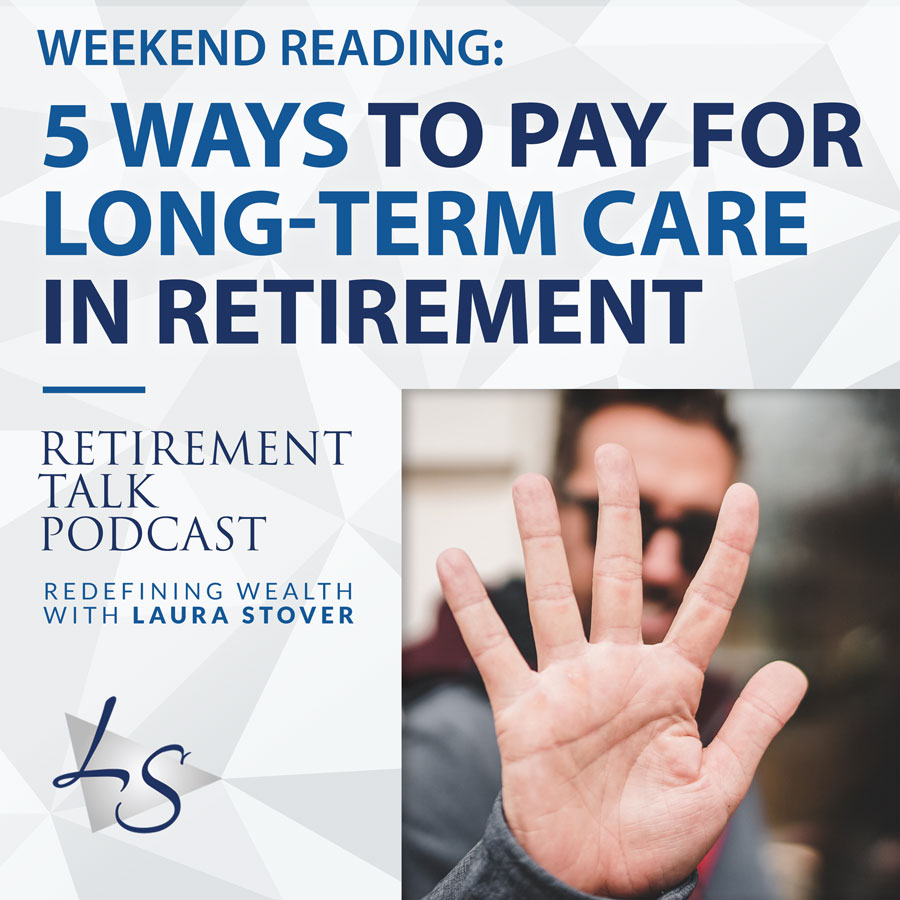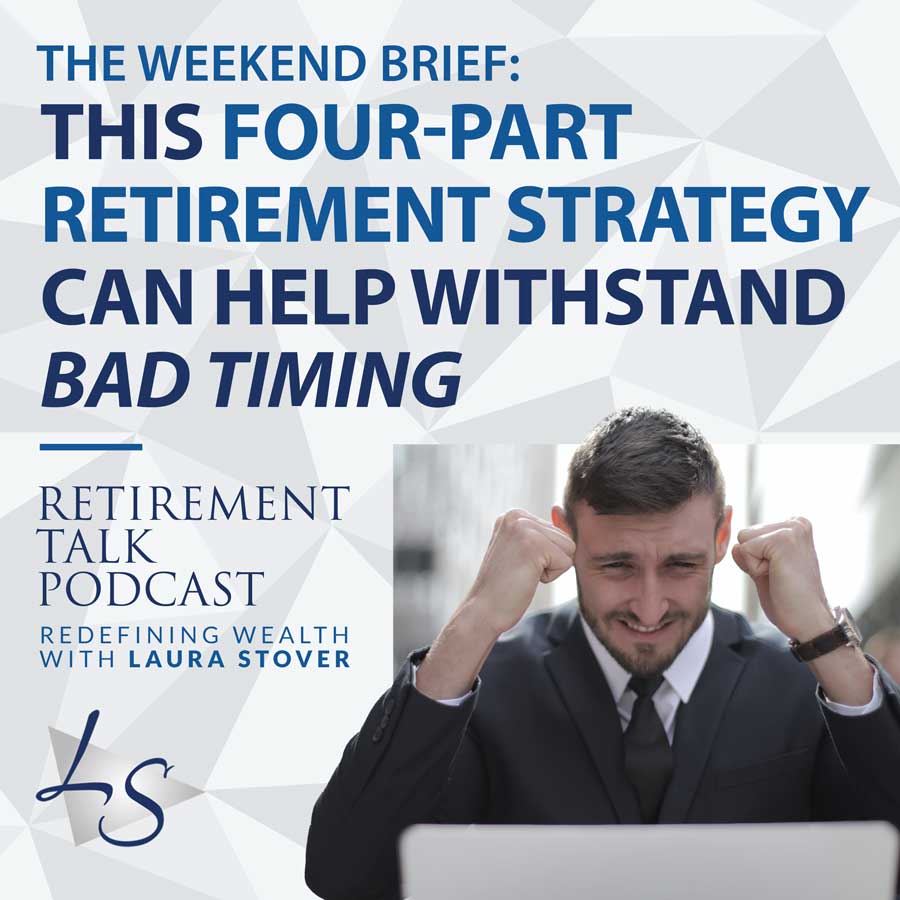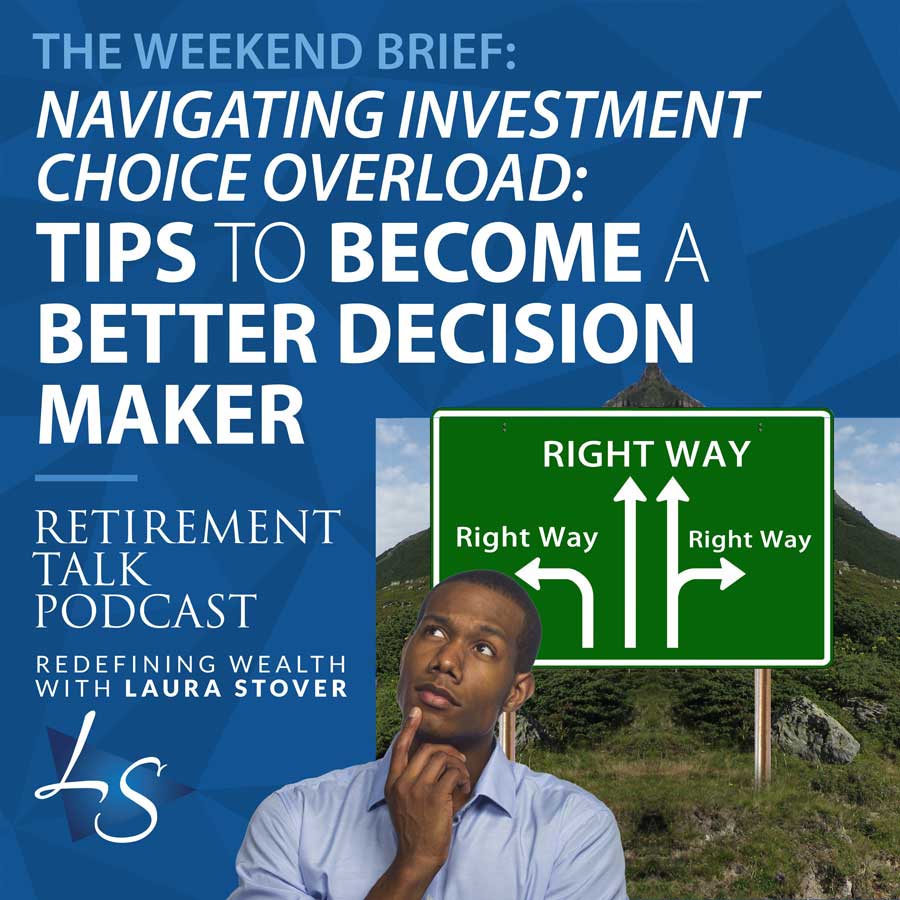If you’re planning out the details of your income and life in retirement, you should also consider what your plan looks like for long-term care in retirement. In this episode, we’re discussing the impact that inflation has had on the costs of long-term care, how you should be protecting your assets, and five ways to cover the costs of long-term care in retirement.
Review the article mentioned in today’s show >>
Rate & Review the Podcast on your favorite podcast app!
Show Notes:
The Impact of Inflation on Cost of Long-Term Care (2:47)
Protecting Your Assets (5:11)
Key Strategies for Covering Costs of Long-Term Care (6:26)
- Out of Pocket Strategy (6:59)
- Traditional Long-Term Care Insurance Policies (11:35)
- Hybrid Life Insurance/Long-Term Care (24:37)
- Life Insurance with Chronic Care Rider (32:01)
- Deferred-Income Annuities (34:29)
Links
Schedule a Review: https://redefiningwealth.info/schedule/
Listen & Subscribe
Ryan Steps:
Welcome to Retirement Talk, the Redefining Wealth show, your source for financial information for pre-retirees and retires to help you better navigate during these financial times. We are here to discuss thoughts and ideas with some of today’s foremost experts in the field of finance and retirement, as well as discuss trending topics and the impact of major legislation that can impact your bottom line. We will break it all down. These discussions can help you make better financial decisions and be informed so you can live the lifestyle you imagine and make better financial choices.
Ryan Steps:
Laura Stover is a registered financial consultant and CEO of LS Wealth Management, as well as founder and owner of LS Tax, a consulting firm. She’s been featured in Forbes, CNBC, and the Wall Street Journal. I’m Ryan Steps. Our topic for today comes from Forbes, five ways to pay long-term care and retirement. If you would like to learn more on today’s topic, head on over to redefiningwealth.info. Schedule a strategy session with Laura Stover and certified financial planner, Michael Wallin. Here are your hosts for today’s show.
Laura Stover:
Hello, hello, hello. Michael, I’m looking forward to a very important topic of discussion today on the topic of healthcare cost and retirement. This is indeed one of the five pillars that everyone needs to plan for, whether you’re pre-retirement 10+ years away or more quite frankly, or already retired. I had a discussion just yesterday. I’ll call her a young woman, just turned 59, and she’s not planning on retiring anytime in the near future. But when I started talking about these risks, right away her interest was on the investment component. But at that stage of life, she hasn’t started an HSA account, a health savings account. Most of her investments are in real estate. She has a bunch of money in the bank and never has invested. So that was a little different type of conversation than what I normally have on a day in and day out basis.
Laura Stover:
But by the time we got to the end of that conversation, she saw the importance of how everything has to coordinate. And Forbes has a great article. If you want to read more, read the show notes on this topic. Simply go to redefiningwealth.info. Much like many other areas of healthcare, specifically today we want to address the cost of long-term care. It is rising like everything else these days, and rising rapidly. It was on a very northern projection before all of the great inflation costs that we are seeing. I should have bought that new front door last year, Michael. The cost this year is unbelievable. But it is what it is. I guess in order to counter it, we either work hard or work longer, or we try to do some planning.
Laura Stover:
And according to a recent study by the US Department of Health and Human Services, more than one in four, one in four retirees will need some type of long-term care at some point in our lives, and the cost is rising more than $100,000 annually. So let’s just pause right here in the aspect of the cost. That’s always the big objection. Oh, if I don’t use it, I’m wasting my money, or I hate insurance, or we have the other side of the fence where families have been through this and the scenarios are much different when you start to enter this situation than what they ever anticipated. Let’s just talk about the cost and the high percentage of people. The fact is, most all of us are going to need some type of long-term care at some point in our life.
Michael Wallin:
Well, when we look at cost, we know that the healthcare, or to be able to provide that personal care that an individual is going to need, those costs are going to rise. That’s going to be an inflationary adjustment throughout a person’s life. Hopefully over a long period of time, if it is a morbidity issue, that gives them a longer duration of life, but does it allow them to have the functionality of their body so that they can provide care for themselves? So one of the things that we’re looking at there is how is those costs going to be paid for. Where are those resources going to be coming from? So if we’re looking at your example or the client that you met with yesterday, Laura, individual, 59, really wanting to grow their assets. That’s kind of the mentality that we’ve been through during our accumulation phase of our life.
Michael Wallin:
It’s always about growing and growing and growing those assets. But so many times what an individual fails to do is to put the safeguard, what we call asset protection, around those resources to make sure that they can either provide and defer the expense or the cost over to an insurance company, put the burden on them, or put a protection around those assets that keeps from having a spend down process. I know we’ll talk more about that as we go further into today’s discussion, but there are steps to protect what you’re building because what good is it to build something if you don’t have it protected and you ultimately just lose it in the future because of these rising costs because you do need to have someone to provide care for you?
Laura Stover:
And to your point, none of us want to be blindsided. That’s a good football term. Justin Fields, my great Ohio state quarterback, he was blindsided a lot this year because the tackle was no good on the Bear’s offensive line. But the reality is long-term care expenses can quickly, very quickly, deplete your lifelong savings. The good news is though you have options and there’s strategies available. That’s what we want to touch on, the key strategies, today. If you start planning ahead of time, that’s truly the key. We don’t wait until we’re diagnosed with dementia or a situation where we know we’re going to be in a vulnerable state where the care is going to expand.
Laura Stover:
Now, here’s several ways to get this thought engine started uncovering some of these costs. The first type of person listening to this, let’s assume you are a multimillionaire. You’re retired. You have no other coverage. You are planning on paying for your long-term care cost. Over and above, Medicare does not pay for long-term care. Medicare supplements do not pay for long-term care, let’s just be real clear. But you are pretty well off. We talk to a lot of clients like this. This is one of the key areas of planning that we have conversations on. And you feel that you can probably, you’re in a position, you can pay most of these costs out of pocket. But again, these costs are very steep.
Laura Stover:
So typically the threshold until this inflation set in, and we saw these recent studies now where these costs are really accelerating, $5 million. The author kind of concurs $5 million is kind of the threshold. The number could be higher or lower depending on if you’re single or if you’re married and what your personal circumstances are. But as far as a personal choice, that’s kind of the threshold. Maybe you’re self sufficient at $5 to $10 million in investable assets. And again, it’s going to depend how long are you going to need care? Today, $5 million doesn’t go as far as it did just a year or two ago, does it?
Michael Wallin:
It doesn’t. When we’re looking at that high net worth individual, and I have a client very similar to this scenario, the family experienced a situation where the mother had gone into the hospital. Some of the medication that was prescribed to her in there caused her to lose her cognitive powers. She has basically been in a trance or a state of a coma. I don’t know what the right medical terminology would be to what she’s been diagnosed with, but this happened. She’s been in this state for about 14 years. The thing, Laura, that was… She was a young woman when this happened. Her body is physically strong. I wouldn’t say she’s in good shape, but for the shape she’s in, she’s in good shape, and they have a long prognosis of her life duration.
Michael Wallin:
And so one of the things that we were seeing is that we were seeing a spin down of about $100,000 a year for the care that she was receiving. So even for a high net worth individual, that they may have the resources to be able to pay for care if it is a short duration scenario. This client of mine right now is on her 17th year in a facility that was brought on by no circumstance of her own, but that has been over $1.7 million that been drained out of their assets simply because they had not put asset protection in place. They had not looked at solutions of diversifying that risk onto an insurance company.
Michael Wallin:
So even when you are looking at a high net worth individual, I think many times those personal choices you mentioned really come into play. Does that individual, are they really seeing their solution to long-term care being the local nursing home or are they wanting to turn a part of their current residence into a facility that would provide those cares? It doesn’t take a lot of additional expenses to dwindle down a $5 million account when you’re starting to do this and you have a long projection on a person’s life expectancy.
Michael Wallin:
So even though I know the author is looking at it in typical terms today of a person gets a need for long-term care, they’re looking at that 14 to 18 month duration, yes, $5 million return on those type of assets, you could probably cover it on your own and it not need to have the expense of an insurance based solution. However, I would say that that is not the best planning. The best planning would be to structure that estate to provide for the care, but also use those insurance solutions because pennies on the dollar is much better than the dollar for dollar expense. And also it might be the solution that you’re going for because there are different types of long-term care planning that can be looked at.
Laura Stover:
Yeah. That’s what we’re going to. Good transition, Michael. We’re going to talk about the different types of planning and just a quick add in on what you just commented. One of my very best friends and a client in south Florida, her mother’s 85. She has a lot of things wrong with her but she loves her home. She has a policy in place that she took out a long time ago. So to my point, the first area of discussion is examining what is referred to as traditional long-term care policies, the pros and the cons. And in this case, the mother, she just turned 85. She has trigeminal. She has a lot of medical issues. She is running to the hospital and needing doctors care on a very regular basis. She contracted COVID last year. Fortunately she’s recovered from the COVID. She was inoculated due to her age and underlying conditions.
Laura Stover:
She made multiple trips though. She had to go more than once for this whole scenario. And we’re in an era where families can’t see each other when you’re in the hospital. What we experienced at some points last year and just a matter of months ago, all the restrictions that were in place. So if your 85-year-old mother is in the hospital, the daughter was not able to go in and see her at that point, but she has hired nursing in her home. Her mental health. She has people around her and she’s doing well considering because she’s happier in her home.
Laura Stover:
The first area of discussion, traditional long-term care policies. This is one of three categories that we’re going to highlight on today’s talk. The traditional policies, they’ve been around for a very long time. We saw an influx of companies, probably in the late ’90s, early 2000s, many carriers that are no longer in the long-term care business today. A lot of people have policies from that long ago. I think the key, if you have an old policy, you need an evaluation. If you’ve had a medical or a health change, you may not qualify to make any changes. So anyone listening, do not act upon this without a thorough evaluation.
Laura Stover:
But traditional policies, I guess the negative side, because of the escalating costs, what we have seen in recent years is a premium being paid by a client by these policies, and in the years that they’re going to need the coverage, now all of a sudden the price and the cost has just skyrocketed, maybe 4% or higher from what they were typically paying because the cost has not been locked in at the point in time that the client may need them. And it also only covers, in most instances, maybe two or four years for two people on a lot of them that I’ve evaluated.
Laura Stover:
So if you don’t use it, you’ll lose it. The price is not locked in and typically the window of coverage is for both the husband and the wife, which is usually a 2, 3, 4 year timeframe for two people to share. If we just review a few quick facts, Genworth did a 2019 cost of care. This survey is already outdated because now since COVID, these costs went up substantially. But the average cost for home healthcare rose over 4.55% just in 2019. Boomers turning 65, there are 10,000 baby boomers turning 65 every single day until 2030. Seven out of 10 will require long-term care in their lifetime. So let’s talk a little bit about the traditional policies, the pros, the cons of having a traditional type policy.
Michael Wallin:
Well, as you mentioned there, Laura, the biggest issue is actuary. It is very difficult for an insurance company to project out what those rising expenses are going to be over the duration of a person’s life. So to remember and just kind of go back for all the listeners to reflect on here, insurance products is a pool of individuals. So when we look at this large pool of people coming together and they are paying the premiums in, but as individuals die off out of that group, you have less payers. And if you have less payers but yet on the other side you have rising costs, you get a deficit between those two numbers, the amount of premium versus the actual amount of expenses.
Michael Wallin:
Now, what insurance companies have to do is they have to go back to the state in which that they operate and they have to show them how their margin has been diminished to actually get an increase in premiums before they can roll that out. So it’s not just an insurance company looking at profitability, that is a very controlled product line for an insurance company. So when an individual has a traditional long-term care policy and they’re seeing the rates go up, they should immediately think, wow, there are more people using this, the cost is rising, and I’m having to pay higher premium. But the problem is their benefits are not increasing by that in typical numbers.
Michael Wallin:
When you buy a plan, you’re buying a daily value. So if you’re buying a daily value of $125 or $130 a day benefit, that’s what you’re buying in the plan. But as you mentioned, Genworth has done some incredible studies over the years and it shows the projection of those inflationary costs. So for individuals that may have a standalone long-term care plan today, those traditional plans, that doesn’t have inflation adjustment, for many of them what they’re going to find at that point of need in the future, that the benefit that they purchased in the past may only be worth 60 to 70% of what they’re actually needing now and that deficit is going to have to come out of their assets to backfill for that daily cost.
Laura Stover:
Well, all long-term care costs rose sharply in 2020, but assisted living facility cost increased the most according to the Genworth, their latest annual cost of care survey. Across the board, we saw escalation in costs due in part to increased costs brought on by none other than our not so popular virus, coronavirus pandemic, and the service that increased most sharply was for private nursing rooms. If you’re in a private room, the cost in 2004 was around $65,185 annually. 2019, the cost was $102,200. I know we’re going to see numbers soon. Now, where we are I could about predict we’re going to see more than $102,200 from 2019 to present. And the last place any of us would’ve wanted to be last year during this pandemic was trapped in a nursing home with the onset of this pandemic.
Laura Stover:
So I think the most dramatic cost increase was for the assisted living facilities. According to the survey, that increased by 68.79% in cost over the last 15 years. So the reason for the climbing long-term care costs are not just due to higher demand. There’s instigating factors pushing these costs higher in order to retain healthcare workers now. We’re in the era of the great resignation. People are changing careers, changing jobs, controversy over the… We’re not getting political, but some healthcare workers are leaving the workforce. I do favor this if you’re in a vulnerable situation, but there’s a good percentage of people leaving healthcare now because of policies that are going on.
Laura Stover:
Some things to keep in mind, and I think the bottom line, if you have a traditional policy, it’s a good idea to have an evaluation. We really have to analyze the cost and what you’re getting for that cost because in my view, having a lifetime benefit rather than just a two or four year benefit for two people, I don’t know about you, Michael, I don’t know what day I’m going to die and I sure do not know how long I might need some type of long-term care. And long-term care is not being able to perform two of the six activities of daily living. Let’s see if we can remember them all: continence, bathing, transferring,
Michael Wallin:
Dressing, feeding yourself, clothing, toileting, transferring, bathing, and then continence, making sure that you have the ability to make decisions. And it doesn’t take a lot for an individual to breach those situations. If a person has really bad arthritis, and let’s just say arthritis. We’ve all heard about Uncle Arthur.
Laura Stover:
Arthur who? Arthur who?
Michael Wallin:
Arthur who, yeah. But arthritis strickens people every day, and it could be an autoimmune disorder that leads this on. But when you take that individual and they lose the ability to use the functions of their hands, they may not be able to provide food. They may not be able to cook their food or feed themselves. They may not be able to bathe themselves or toilet themselves. That individual stricken by Uncle Arthur there could meet their two of their six ADLs, as you mentioned, and that all of a sudden would cause them to have the ability to qualify for care.
Michael Wallin:
Now, one thing about the long-term care that’s a standalone plan is you also want to know, do you get home healthcare or does it require you to be institutionalized into a convalescent facility? Because if you have arthritis and it is really bad arthritis, are you ready now to leave your home and go live in an institution, a convalescent home, just because you lose the functionality of your hands because of arthritis, are you ready to really leave your home?
Michael Wallin:
So you really want to make sure on these plans that you have a progressive care strategy in that solution, meaning that if I’m not requiring 24/7 care, can I get that care that I need at home? And then could I possibly go to an adult daycare during the day that may allow my loved ones to be able to work during the day and then be able to provide care for me in the evenings. And then from there, does it progress to the assisted living where I may need to be in a facility but it’s still more like an apartment. And ultimately then move into that convalescent. And so is it a progressive care or does that plan that you have today only provide if you go and live in a facility? And I think it’s very important on that review.
Laura Stover:
Yeah. Absolutely. And now what we want to kind of transition to, so the traditional policies, making sure we understand what it’s covering and what it’s not, if it’s sufficient for two people, which most of them are not, and understanding that the price typically escalates at some point in the future when you’re going to need the coverage. And the other activity of daily living or a qualifying factor to trigger a benefit on most all of these policies is if you develop some type of a dementia as well. That we are seeing people live a very, very long time but their mental capacity, they may need someone to monitor them. They can’t be left alone for long periods of time. Can’t imagine I would be one of those types of individuals.
Michael Wallin:
We can’t leave you for long periods of time by yourself now, Laura.
Laura Stover:
I was going to say when it comes to trying to cook in the kitchen, you don’t want to leave me behind the stove too long in there either. Sometimes it works out and sometimes it doesn’t. We have two more types of coverage that we want to address here today. Let’s do one more here before the break. Hybrid life insurance/long-term care. Now, I think we’re transitioning from that traditional discussion to… We’ve laid the groundwork. 70% of us, Morningstar, Genworth. There’s hundreds of studies. If you’re not convinced that you’re going to need some type of healthcare planning in retirement, I say you are going to need some type of planning. Aim at nothing and you surely will hit it is something that always stuck with me from one of my college professors.
Laura Stover:
The hybrid policy, this has become much more common with life insurance companies to offer what’s known as a LTC or long-term care rider. I know we’re both quite fond of this option for a multitude of reasons. Beneficiaries would receive a death benefit if you don’t utilize all of the long-term care benefits, but you have key benefits if you qualify for this. Number one, if you are one of those small percentage of individuals that isn’t going to use the long-term care, you don’t want to pay for something you’re not going to use, then there’s a tax free that’s also part of the estate plan, second to die provision that goes to your beneficiary. That’s a strong proposition for hitting, I guess, two birds with one stone. It has a level premium.
Laura Stover:
We talked about the traditional, those premiums are not locked in. That can be problematic. Level premium, or you can invest all in it up front and never pay another dime. It’s called paid up. There’s a lifetime benefit factor. This is huge for both spouses. I always chuckle at the couple where there’s husbands, Michael, they’re like 250 pounds. “Oh, I don’t need no insurance, but she can have it.” I had this conversation and I’m at the age now I can say, “So she can have the insurance on her, but you don’t want it and you expect her, because she’s your wife, to lift you.” I use some choice words. “To lift you around. You’re about 250+ pounds. She’s going to help you because you don’t want a policy and she’s your wife and she does love you. So she’s probably going to try to help you, and she’s a very small, petite woman.” And then that’s kind of sunk in. Really if anyone should get, it’s probably the husband more than the wife because of a number of things.
Laura Stover:
But both people are going to need the coverage, but it’s a lifetime benefit on both lives. So we’re not restricted to the two or the four year window for two people unlike with those traditional policies. And then the death benefit in the rare instance you never use the policy. Is there as a second to die provision? These are great tools to have your diversification with your financial plan in place, I think. I don’t want to be pressured. I want to stay in my home as long as possible. So you can utilize benefits for home modifications. There’s all types of independence that can be achieved from being empowered by having something in place, and whether it pays for 25%, 30% or 40% of the overall cost, that’s really kind of the goal.
Michael Wallin:
Well, and they’re customizable. Based upon where you are, you can dictate how much money you want to put into the plan to either ratchet up or reduce down what that daily benefit is going to be. I love these plans. I think it is the best strategy, and really I don’t even think it’s a decision. As you mentioned earlier, Laura, seven out of 10 people are going to need that. Let’s just frame that up and unpack this for a second. When we look at that, that means you’ve got 10 individuals. If seven out of 10 are going to live long enough to need benefit, that means three individuals died too soon. So you’ve got seven people that lived too long and you’ve got three people that died too soon.
Michael Wallin:
But with this plan, all of them have a benefit that is paid out to them. It’s either going to come in the form of providing for personal care or it’s going to provide for skilled care. It’s going to give them the flexibility of choosing where they’re going to receive that care based upon the provisions of the contract and that they also qualify for the contract. But the other side is if it happens to be those three people in that scenario that die too soon, they’re going to leave a tax free benefit to their loved ones that’s going to make up the gap of loss of social security, potential loss of a pension. There’s revenue streams that may be diminished because of the loss of life. These dollars are going to come in and backfill that.
Michael Wallin:
So either way, this plan is going to pay out based just upon whichever situation presents itself first to the policy owner. So I think it’s the best planning. But I really, when I sit down with clients, Laura, I’m not even suggesting to them it’s a big decision they need to make, it’s the next step in the process. If you’re going into retirement and really if you’re between that five and seven years before retirement, I think that is where your window opens up that you go ahead and you establish a long-term care plan in place because you’re really now putting asset protection around your estate as you move through retirement and it’s not about you, it is about your loved ones.
Michael Wallin:
It’s going to provide institutional care for you, but it’s also for that community spouse making sure that you do not dwindle down your shared assets and leave them impoverished in their later part of life because they may outlive you by 15 or 20 years, but all of those resources that y’all built together during your accumulation phase, if it goes in a short window of paying for care for you, you have really put your loved one in a detrimental position because of their longevity during their retirement.
Ryan Steps:
We’re talking today about long-term care costs with Laura Stover and Michael Wallin. For a strategy session with Laura and Michael, go to redefiningwealth.info and click review. We take a deep dive into your particular situation. We’ll meet with you by phone, virtually or in-person. Again, go to redefiningwealth.info. Look at healthcare risk. This is one of the five key areas of risk we will cover with you through the redefining wealth process. Now back to retirement talk, the Redefining Wealth Show with Laura Stover and Michael Wallin.
Laura Stover:
The last two categories on our long-term care discussion, the cost of long-term care, a key planning pillar. This is part of the five pillars of risk that I’ve identified. We have carved out the framework, the Redefining Wealth Framework. This all revolves around the income planning component. Having a plan in place for these costs and aligning yourself with the best possible plan, what makes sense for you and your family. The next one, Michael, we’ve spoken about traditional long-term care policies. We’ve spoken about the hybrid solution, which is our favorite in most situations because of the lifetime benefit, the costs do not increase. They’re locked in.
Laura Stover:
Next though, this is popular in some instances, a life insurance policy with a chronic care rider. What this means, this is not necessarily going to be in most instances, from the evaluations I’ve done, enough to last for a lifetime benefit. Maybe not even much past 24 months depending on the size of the death benefit. But it is a great tool to have your life insurance evaluated and making sure you know what the purpose of it’s for. But some of these policies allow you to access a certain portion of your death benefit early, it’s called an accelerated death benefit, if you need LTC, long-term care insurance. If you’re terminally ill, you can access a portion. If you’re chronically ill, if you’re critically ill. And it’s very flexible when it comes to getting value from your life insurance while you’re still alive, and I’ve heard it called life insurance. You don’t have to die to use it.
Laura Stover:
Policies like this allow you to access a specific portion of that death benefit early. Again, you’d qualify for two of the six activities of daily living that would trigger the accelerated benefit. So in other words, if you have let’s just say $100,000 policy or a $200,000 death benefit, in most instances the chronic and critical care, if I’m chronically ill, I have a kidney dialysis situation, I have a cancer situation; if I’m critically ill, I just had a heart attack, I had a stroke, you’re going to get about 24, 25% in most cases of access to the death benefit. If you’re terminally ill, it can be I’ve seen as high as 90. And if you qualify… Let’s face it, we’re either going to die and need the death benefit. We’ll be critically, chronically or terminally ill. I think it has all factors covered of possible scenarios. So this usually is a little bit more affordable option for those on a budget but need to have some type of plan in place.
Laura Stover:
Now, the last one, and I think this one here is an option and you would maybe agree, Michael, a deferred income annuity. Now, this is not tax free life insurance proceeds, but for the person who has nothing in place, they hear our show, they call, they talk to us. We strategize. We look at their situation, we look at their needs. And they maybe have a health condition now where they don’t qualify for anything. You have a diabetic situation coupled with something else perhaps, or that arthritis diagnosis sometimes can cause problems qualifying for policy.
Laura Stover:
So this could potentially be an option as a source of additional retirement income that can be pulled using a rider. And these are specific types of long-term care annuities that are out there today where you can… It’s about boosting the income. For these types of situation, it is providing you with more income. I like this, especially if you have an individual who’s not in an ideal health situation or maybe they’re underfunded with a traditional policy but they have a health condition now, they really can’t give up that traditional policy even though in most cases most of them are kind of flawed but they need to keep it in place. This could be a nice supplement to the plan, or if you have nothing in place at all. It’s an option if you have a bad health situation in my view.
Michael Wallin:
And oftentimes we’ll use annuities. I’ve done a lot of Medicaid annuities over the years, and that kind of gets into the income planning, which is one of the other pillars that we look at because when a person is going to go into a nursing home, one of the things that’s going to happen is they’re going to take a snapshot of all of their assets. When we look at that, assets are deferred. If things are counted as income, so oftentimes we will transition assets into a Medicaid annuity. And every state does not offer these. You do need to work with that professional that knows the state rules, which is one of the things that we do. We look at what are available in all 50 states and what the state allows for how much community dollars can be there and to what level it’s considered for impoverished. In most cases, you can be down to $2,000 of assets.
Michael Wallin:
But what we look at is transitioning the dollars to make sure that the community spouse is being taken care of. That allows us to put the dollars in. It creates an income source for the community spouse. Oftentimes, what is a requirement is though that the nurse or the state has to be listed as the beneficiary of the annuity for at least the amount of the long-term care cost that was provided to the institutionalized spouse. This is an area that you really need to be working with someone that knows the rules, that can implement them and put it in place. But annuities can be a very favorable place of being able to put dollars in and plan for long-term care.
Michael Wallin:
This is what I would call critical planning, Laura. I like to do pre-planning through hybrid long-term care solutions in most scenarios because we know what we’re going to have and we’re not just trying to get the minimum care for the institutionalized to provide for the community, but we’re providing the absolute best care for both scenarios. Kind of the takeaway for long-term care is when you’re doing this planning, when you’re sitting there with your spouse, the goal is that you are the care manager, not the caregiver. And a simple step in planning can allow you the ability to provide that love and care for them without it being detrimental to your own health as you’re trying to provide care. And oftentimes that loved one will do more injury and harm to the sick spouse because they are not trained, they are not equipped to providing that care, and this is a reason why we need to have professionals doing their job, but doing simple planning can provide care for both loved ones.
Laura Stover:
Let me just end by saying there’s very specific annuities. So again, this is not necessarily just because you have an annuity, it doesn’t mean that it is in alignment with what we’re talking about. Two quick items. There’s income riders these days on a lot of annuities that provide for more income if you cannot perform two of the six activities of daily living. And there’s also what came out in the summer of 2014, the IRS and Treasury Department finalized the creation of qualifying longevity annuity contracts, or known as Q-L-A-C-S, QLACs, under the required minimum distribution rules of the internal revenue code.
Laura Stover:
This is something to make sure that you’re working with the right team so you have a clear plan for your retirement. You can read more in the show notes, schedule a strategy session with Michael or myself. We’re happy to hop on a quick call with you. So many listeners are calling in and taking advantage of that. Go to redefiningwealth.info, click on schedule review, schedule a 15 minute consultation. We’ll do this in the comfort of your home virtually or by phone. It’s been a pleasure as always, Michael. Again, go to redefiningwealth.info.
Ryan Steps:
Redefining Wealth is a registered trademark of LS Wealth Management. Take advantage of a complementary plan. Know where you stand regardless of the market. Walk through the Redefining Wealth process and have a clear picture of the key risks you likely will face and achieve a deeper understanding of how to properly plan for these risks with a Redefining Wealth Framework. Schedule a strategy session now by going to redefiningwealth.info, click schedule.
Ryan Steps:
Redefining Wealth is a registered trademark of LS Wealth Management. Investing involves risk, including the potential loss of principal. Any references to protection, safety, or lifetime income generally refer to fixed insurance products, never securities or investments. Insurance guarantees are backed by the financial strength and claims paying abilities of the issuing carrier. This show is intended for informational purposes only. It is not intended for use as the sole basis for financial decisions nor should it be construed as advice designed to meet the particular needs of an individual situation.
Ryan Steps:
LS Wealth Management LLC is not permitted to offer, and no statement made during this show shall constitute tax or legal advice. Our firm is not affiliated with or endorsed by the US government or any governmental agency. The information and opinions contained herein provided by third parties have been obtained from sources believed to be reliable, but accuracy and completeness cannot be guaranteed by LS Wealth Management LCC. Investment advisory service is offered through Optimize Advisory services and SEC registered investment advisors. LS Wealth Management is a separate entity.












